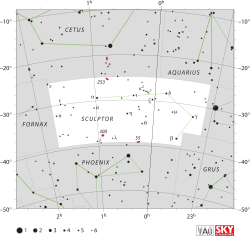Kappa1 Sculptoris
| Kappa1 Sculptoris (κ1) | |
 | |
| Observationsdata Epok: J2000.0 | |
|---|---|
| Stjärnbild | Bildhuggaren |
| Rektascension | 00t 09m 21,06696s[1] |
| Deklination | -27° 59′ 16,5322″[1] |
| Skenbar magnitud () | +5,51 (6,23 + 6,29)[2] |
| Stjärntyp | |
| Spektraltyp | F2 V[3] (F4 III + F3 III)[2] |
| U–B | +0,06[4] |
| B–V | +0,42[4] |
| Astrometri | |
| Radialhastighet () | +7,7 ± 1,6[5] km/s |
| Egenrörelse (µ) | RA: +70,11[1] mas/år Dek.: -8,97[1] mas/år |
| Parallax () | 12,91 ± 0,72[1] |
| Avstånd | 250 ± 10 lå (77 ± 4 pc) |
| Absolut magnitud () | +2,05[6] |
| Detaljer | |
| Massa | 1,53[7] M☉ |
| Luminositet | 31,3[8] L☉ |
| Temperatur | 6 697 ± 228[7] K |
| Metallicitet | +0,05[9] dex |
| Vinkelhastighet | 116,8 ± 5,8[6] km/s |
| Ålder | 2,0[7] miljarder år |
| Andra beteckningar | |
| κ1 Scl, CD- 28° 16, HD 493, HIP 761, HR 24, SAO 166083, ADS 111, WDS J00094-2759AB [10] | |
Kappa1 Sculptoris (κ1 Sculptoris, förkortat Kappa1 Scl, κ1 Scl) som är stjärnans Bayerbeteckning, är en dubbelstjärna belägen i den norra delen av stjärnbilden Bildhuggaren. Den har en kombinerad skenbar magnitud på 5,51[2] och är svagt synlig för blotta ögat där ljusföroreningar ej förekommer. Baserat på parallaxmätning inom Hipparcosuppdraget på ca 12,9[1] mas, beräknas den befinna sig på ett avstånd på ca 250 ljusår (ca 77 parsek) från solen.
Egenskaper
[redigera | redigera wikitext]Primärstjärnan Kappa1 Sculptoris A är en gulvit jättestjärna av spektralklass F4 III[2]. Den har en massa som är drygt 50[7] procent större än solens massa och utsänder från dess fotosfär ca 31[8] gånger mera energi än solen vid en effektiv temperatur på ca 6 700[7] K.
Följeslagaren Kappa1 Sculptoris B, är av spektralklass F3 III.[2] Stjärnparets kompositspektrum är klassificerat som F2V.[3] Paret kretsar kring varandra med en uppskattad omloppsperiod på 616 år och en excentricitet på 0,1.[11] En annan följeslagare av 18:e magnituden ligger separerad med 73,4 bågsekunder vid en positionsvinkel på 243° (år 1998).[12]
Källor
[redigera | redigera wikitext]- Den här artikeln är helt eller delvis baserad på material från engelskspråkiga Wikipedia, tidigare version.
Referenser
[redigera | redigera wikitext]- ^ [a b c d e f] van Leeuwen, F. (2007), "Validation of the new Hipparcos reduction", Astronomy and Astrophysics, 474 (2): 653–664, arXiv:0708.1752 , Bibcode:2007A&A...474..653V, doi:10.1051/0004-6361:20078357.
- ^ [a b c d e] Eggleton, P. P.; Tokovinin, A. A. (September 2008), "A catalogue of multiplicity among bright stellar systems", Monthly Notices of the Royal Astronomical Society, 389 (2): 869–879, arXiv:0806.2878 , Bibcode:2008MNRAS.389..869E, doi:10.1111/j.1365-2966.2008.13596.x.
- ^ [a b] Houk, Nancy (1979), "Michigan catalogue of two-dimensional spectral types for the HD stars", Michigan Catalogue of Two-dimensional Spectral Types for the HD stars. Volume_3. Declinations -40_ƒ0 to -26_ƒ0, Ann Arbor, Michigan: Dept. of Astronomy, University of Michigan, 3, Bibcode:1982MSS...C03....0H.
- ^ [a b] Hurly, P. R. (1975), "Combined-light UBV Photometry of 103 Bright Southern Visual Doubles", Monthly Notes of the Astronomical Society of Southern Africa, 34: 7, Bibcode:1975MNSSA..34....7H.
- ^ de Bruijne, J. H. J.; Eilers, A.-C. (October 2012), "Radial velocities for the HIPPARCOS-Gaia Hundred-Thousand-Proper-Motion project", Astronomy & Astrophysics, 546: 14, arXiv:1208.3048 , Bibcode:2012A&A...546A..61D, doi:10.1051/0004-6361/201219219, A61.
- ^ [a b] Ammler-von Eiff, M.; Reiners, A. (2012), "New measurements of rotation and differential rotation in A-F stars: are there two populations of differentially rotating stars?", Astronomy & Astrophysics, 542: 31, arXiv:1204.2459 , Bibcode:2012A&A...542A.116A, doi:10.1051/0004-6361/201118724, A116.
- ^ [a b c d e] David, Trevor J.; Hillenbrand, Lynne A. (2015), "The Ages of Early-Type Stars: Strömgren Photometric Methods Calibrated, Validated, Tested, and Applied to Hosts and Prospective Hosts of Directly Imaged Exoplanets", The Astrophysical Journal, 804 (2): 146, arXiv:1501.03154 , Bibcode:2015ApJ...804..146D, doi:10.1088/0004-637X/804/2/146.
- ^ [a b] McDonald, I.; et al. (2012), "Fundamental Parameters and Infrared Excesses of Hipparcos Stars", Monthly Notices of the Royal Astronomical Society, 427 (1): 343–57, arXiv:1208.2037 , Bibcode:2012MNRAS.427..343M, doi:10.1111/j.1365-2966.2012.21873.x.
- ^ Casagrande, L.; et al. (2011), "New constraints on the chemical evolution of the solar neighbourhood and Galactic disc(s). Improved astrophysical parameters for the Geneva-Copenhagen Survey", Astronomy & Astrophysics, 530 (A138): 21, arXiv:1103.4651 , Bibcode:2011A&A...530A.138C, doi:10.1051/0004-6361/201016276.
- ^ "kap01 Scl -- Double or multiple star", SIMBAD Astronomical Database, Centre de Données astronomiques de Strasbourg, hämtad 2017-06-01.
- ^ Hartkopf, W. I.; et al., Sixth Catalog of Orbits of Visual Binary Stars, United States Naval Observatory, hämtad 2017-06-02
- ^ Mason, B. D.; et al. (2014), The Washington Visual Double Star Catalog, Bibcode:2001AJ....122.3466M, doi:10.1086/323920, retrieved 2015-07-22
| ||||||||||||||||





